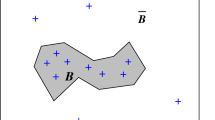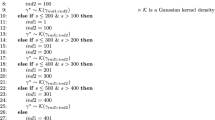Abstract
In any depositional environment, the sequence of sediments follows specific high- and low-frequency patterns of rock occurrences or events. The occurrence of a rock in a spatial location is conditional to a prior rock event at a distant location. Subsequently, a third rock occurs between the two locations. This third event is conditional to both prior events and is driven by a third-order conditional probability P(C ∣ (A ∩ B)). Such probability has to be characterized beyond the classic conditional independence model, and this research has found that exact computation requires a third-order co-cumulant term. The co-cumulants provide the higher-order redundancy among multiple indicator variables. A Bayesian analysis has been performed with “known” numerical co-cumulants yielding a novel model of conditional probability that is called the “Kappa model.” This model was applied to three-point variables, and the concept has been extended for multiple events P(G ∣ A ∩ B ∩ C ∩ D... ∩ N), allowing the reproduction of complex transitions of rocks in sequence stratigraphy. The Kappa model and co-cumulants have been illustrated with simple numerical examples for clastic rock sequences. In addition, the co-cumulant has been used to discover an extension of the variogram called the indicator cumulogram. In this way, multiple prior events are no longer ignored for evaluating the probability of a posterior event with higher-order co-cumulant considerations.
Similar content being viewed by others
References
Fisher, R.A.: Moments-and-product moments of sampling distributions. Proc. Lond. Math. Soc. Ser. 2, vol. 30, pp. 199–238. University of Adelaide Press (1972) (Reprinted In: Bennett, J.H. (ed.) Collected Papers of RA Fisher, vol. 2, pp. 351-354 (1929))
Galloway, W.E.: Process framework for describing the morphologic and stratigraphic evolution of deltaic depositional systems. In: Broussard M.L. (ed.) Deltas: Houston Geological Society, pp. 87–98 (1975)
Guardiano, F., Srivastava, R.M.: Multivariate geostatistics: beyond bivariate moments. In: Soares A (ed.) Geostatistics Troia, vol 1., pp. 133–144. Kluwer, Dordrecht (1993)
Journel, A.G., Alabert, F.: Non-Gaussian data expansion in the earth sciences. Terra Nova 1(1), 123–134 (1989)
Journel, A.G.: Combining knowledge from diverse sources: an alternative to traditional data independence hypotheses. Math. Geol. 34(4), 573–596 (2002)
Krumbein, W.C., Dacey, M.F.: Markov chains and embedded Markov chains in geology. Math. Geol. 1(1), 79–96 (1961)
Mitchum, R.M., Van Wagoner, J.C.: High frequency sequences and their stacking patterns: sequence-stratigraphic evidence of higher-frequency eustatic cycles. J. Sediment. Geol. 70, 131–160 (1991)
Nikias, C.L., Petropulu, A.P.: Higher order spectra analysis: a nonlinear signal processing framework. Prentice Hall, New York (1993)
Ravenne, C., Galli, A., Dolingez, B., Beucher, H., Eschard, R.: Quantification of facies relationships via proportion curves. In: Armstrong, M., Bettini, C., Champigny, N., Galli, A., Remacre, A. (eds.) Geostatistics Rio 2000, pp. 19–39. Kluwer, Dordrecht (2002)
Strebelle, S.: Conditional simulation of complex geological structures using multiple-point statistics. Math. Geol. 34(1), 1–21 (2002)
VanWagoner, J.C., Mitchum, R.M., Campion, K.M., Rahmanian, V.D.: Siliciclastic sequence stratigraphy in well logs, cores, and outcrops: concepts for high-resolution correlation of time and facies. AAPG Methods in Exploration Series 7 (1990)
Vargas-Guzmán J.A., Qassab, H.: Spatial conditional simulation of facies objects for modeling complex clastic reservoirs. J. Petrol. Sci. Eng. 54, 1–9 (2006)
Vargas-Guzmán J.A.: Higher-order spatial estimation and stochastic simulation of continuous properties with cumulants and higher order non-Gaussian distributions. In: Ortiz J, Emery X. (eds.) Geostats 2008, pp. 429–438. Gecamin, University of Chile (2008)
Author information
Authors and Affiliations
Corresponding author
Rights and permissions
About this article
Cite this article
Vargas-Guzmán, J.A. The Kappa model of probability and higher-order rock sequences. Comput Geosci 15, 661–671 (2011). https://doi.org/10.1007/s10596-011-9234-6
Received:
Accepted:
Published:
Issue Date:
DOI: https://doi.org/10.1007/s10596-011-9234-6




